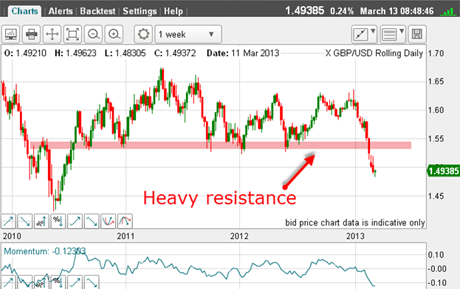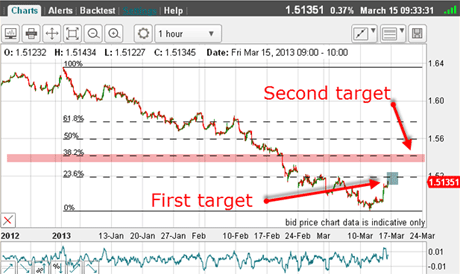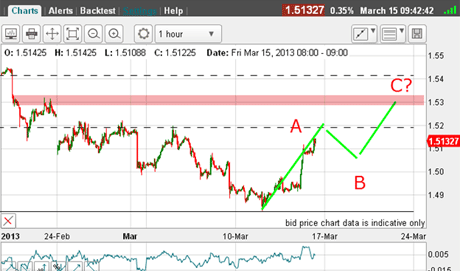Now the pound rallies – how should we trade?
Using his analysis of the charts, John C Burford explains the ways in which traders could profit from the pound's recent rally in a long-term bear market.
On Wednesday, I analysed the GBP/USD market, which has suffered a steep decline in 2013.
I set out my swing trading strategy, looking for a turn. Since then the market has followed my scenario, up around 300 pips from Tuesday's low.
One of the key factors at work is the sentiment background, which is fuelling the current rally.
MoneyWeek
Subscribe to MoneyWeek today and get your first six magazine issues absolutely FREE

Sign up to Money Morning
Don't miss the latest investment and personal finances news, market analysis, plus money-saving tips with our free twice-daily newsletter
Don't miss the latest investment and personal finances news, market analysis, plus money-saving tips with our free twice-daily newsletter
Forget the news, the headlines, the fundamentals', the gurus and what they are reported as saying unless you are using it to judge sentiment.
Let's see why this is so.
Imagine a market which is demonstrably bullish. The commitments of traders (COT) data confirms this, the articles in the specialist and popular media confirm it, the surveys confirm it, and the basic theme behind the rise makes a lot of sense.
Then, a surprise piece of news emerges which is on-the-surface very bearish. A casual observer would say that the market should experience at least a hefty sell-off, perhaps a trend change.
That may happen, but if the sentiment picture doesn't change, this dip will be temporary and the bull market will likely resume.
And this bearish news item may be shrugged off by the determined bulls, who use the dip to buy more and drive the rally further!
There have been a multitude of examples in history.
I well remember in 1963 when President Kennedy was assassinated the stock market did dip, but within a few days, was back making new highs. It was in a strong bull market.
More recently in September, the Fed announced a big extension in the quantitative (QE) programme that should have rallied Treasuries.
But since then, T-Bond yields have risen substantially. Why? Because Treasuries were in a new bear market yields bottomed in August! And that new bear market is being driven by a change in sentiment.
On the surface, the Fed's action should be supportive of bonds. After all, they had made a promise to buy up most of the new bonds and notes. With such a prominent major buyer, what was to stop the market from rallying further?
Evidently, there was another factor and that was a change in sentiment.
Market swings are driven by swings in sentiment from bullish to bearish and back again in the great rhythm of the markets.
Once you understand what is really driving the markets, they become much easier to trade, believe me.
Just understand that the news follows the markets.
Checking in on my sterling trade
OK, back to the pound. Last time, I gave a possible upside target as the underside of the huge zone of resistance in the pink zone:

(Click on the chart for a larger version)
Because we are dealing with a rally in a bear market, we must be on the lookout for an A-B-C pattern.
Here is the hourly chart showing the decline off the 2 January top:

(Click on the chart for a larger version)
It surely was a bloodbath for the bulls!
So what is my preferred scenario for this rally?
We have a major low in place, so I can draw in my Fibonacci levels from the 1.63 top. The first level at 23% at 1.53 lies just ahead, and that will be my first preferred target. There's strong resistance at that level - see the reversals of the attempted rallies in late February/early March.
Then, I would like to see a push up to the pink zone in a final C wave. This is my preferred scenario:

(Click on the chart for a larger version)
OK, this is definitely not a forecast simply a way the market could arrive at the pink zone if it so wishes.
On Wednesday, I outlined how different traders could be playing this. A short-term trader who was still holding a long position may be looking at taking profits at the A wave high, and then looking to get back long near the B wave low and looking at the C wave high to exit with a great series of trades.
A swing trader might be holding long positions and waiting for the pink zone to exit.
A much longer-term trader would still be short, and looking to add to positions on this rally.
All of which goes to show that there is no one right way to trade. The only rule is to lose as little as possible on losing trades, and extract as much profit as possible on your winners.
If you're a new reader, or need a reminder about some of the methods I refer to in my trades, then do have a look at my introductory videos:
The essentials of tramline trading
An introduction to Elliott wave theory
Advanced trading with Elliott waves
Don't miss my next trading insight. To receive all my spread betting blog posts by email, as soon as I've written them, just sign up here . If you have any queries regarding MoneyWeek Trader, please contact us here.
Get the latest financial news, insights and expert analysis from our award-winning MoneyWeek team, to help you understand what really matters when it comes to your finances.
John is is a British-born lapsed PhD physicist, who previously worked for Nasa on the Mars exploration team. He is a former commodity trading advisor with the US Commodities Futures Trading Commission, and worked in a boutique futures house in California in the 1980s.
He was a partner in one of the first futures newsletter advisory services, based in Washington DC, specialising in pork bellies and currencies. John is primarily a chart-reading trader, having cut his trading teeth in the days before PCs.
As well as his work in the financial world, he has launched, run and sold several 'real' businesses producing 'real' products.

